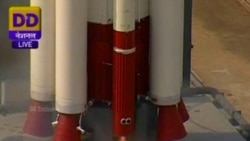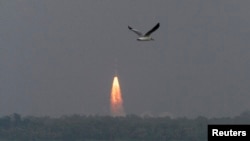NEW DELHI —
India has taken a giant leap in its space program by launching a spacecraft bound for Mars. If the country’s first interplanetary foray is successful, India will become the first Asian country and the fourth worldwide to conduct a mission to the Red Planet.
As a nation watched from its television screens, the 1,350 kilogram unmanned satellite hurtled into space Tuesday afternoon from Sriharikota on the country’s east coast.
Within 45 minutes of the launch of the Mars Orbiter mission, Indian Space Research Organization (ISRO) Chairman K. Radhakrishnan announced that it is going according to plan.
“I am very happy to announce that the PSLV C 25 vehicle has placed the Mars Orbiter spacecraft very precisely into an elliptical orbit around earth… it has been a new and complex mission,” said Radhakrishnan.
The launch, a proud moment for India, was beamed live. The ambitious goal of reaching earth’s closest neighbor has been attempted by major space faring nations. But only three have achieved success - the United States, Russia and the European space agency.
Analysts say competition with China prompted India to assemble the mission at short notice. It was formally announced last August by Prime Minister Manmohan Singh. That was after a Chinese mission to Mars in 2011 failed.
Scientists say the Indian mission is primarily meant to develop the technology to design and conduct interplanetary missions.
Tuesday’s successful launch is only the first milestone in this challenging task. Its major test will come nine months on when the spacecraft enters the Mars orbit.
ISRO spokesman, Deviprasad Karnik, explains the critical stages in the Mars Oribter mission.
“By 30th of November the spacecraft is going to leave the influence of sphere of earth and will be on a long trajectory towards Mars for about 300 days. At the end of 300 days, it has to be captured by the Martian orbit. We are expecting this to happen by September of 2014,” said Karnik.
Equipped with five instruments, the Indian spacecraft will explore the surface features, atmosphere and geology of the Red Planet. It will also search for methane, which is key to supporting life.
India has billed its Mars mission as a low cost mission to counter criticism that a country which still confronts major challenges in combating poverty should not spend its resources on a probe with no tangible benefits for its poor.
Indian leaders say the $73 million cost is well within the emerging economy’s reach and it represents a huge advance in its space program, which has many social goals. They say the mission will serve to demonstrate that India is developing cost affordable and effective space technology.
There is a huge sense of excitement and optimism among space scientists. The mission to Mars has been put together with technology tested during an unmanned mission to the moon in 2008.
Although that had to be aborted early, India declared it a success after it found evidence of water on the moon.
Former chairman of ISRO, Krishnaswamy Kasturirangan, who played a key role in the moon mission, summed up the mood.
“This is an incredible exciting moment and you pulled it off in a very beautiful and professional manner,” he said.
But with so much riding on the long journey to Mars, scientists did not rely on their skills alone. As the countdown began Sunday, the chief of India’s space program, Radhakrishnan offered prayers at the famous Tirupati temple with miniature replicas of the spacecraft and the rocket.
As a nation watched from its television screens, the 1,350 kilogram unmanned satellite hurtled into space Tuesday afternoon from Sriharikota on the country’s east coast.
Within 45 minutes of the launch of the Mars Orbiter mission, Indian Space Research Organization (ISRO) Chairman K. Radhakrishnan announced that it is going according to plan.
“I am very happy to announce that the PSLV C 25 vehicle has placed the Mars Orbiter spacecraft very precisely into an elliptical orbit around earth… it has been a new and complex mission,” said Radhakrishnan.
The launch, a proud moment for India, was beamed live. The ambitious goal of reaching earth’s closest neighbor has been attempted by major space faring nations. But only three have achieved success - the United States, Russia and the European space agency.
Analysts say competition with China prompted India to assemble the mission at short notice. It was formally announced last August by Prime Minister Manmohan Singh. That was after a Chinese mission to Mars in 2011 failed.
Scientists say the Indian mission is primarily meant to develop the technology to design and conduct interplanetary missions.
Tuesday’s successful launch is only the first milestone in this challenging task. Its major test will come nine months on when the spacecraft enters the Mars orbit.
ISRO spokesman, Deviprasad Karnik, explains the critical stages in the Mars Oribter mission.
“By 30th of November the spacecraft is going to leave the influence of sphere of earth and will be on a long trajectory towards Mars for about 300 days. At the end of 300 days, it has to be captured by the Martian orbit. We are expecting this to happen by September of 2014,” said Karnik.
Equipped with five instruments, the Indian spacecraft will explore the surface features, atmosphere and geology of the Red Planet. It will also search for methane, which is key to supporting life.
India has billed its Mars mission as a low cost mission to counter criticism that a country which still confronts major challenges in combating poverty should not spend its resources on a probe with no tangible benefits for its poor.
Indian leaders say the $73 million cost is well within the emerging economy’s reach and it represents a huge advance in its space program, which has many social goals. They say the mission will serve to demonstrate that India is developing cost affordable and effective space technology.
There is a huge sense of excitement and optimism among space scientists. The mission to Mars has been put together with technology tested during an unmanned mission to the moon in 2008.
Although that had to be aborted early, India declared it a success after it found evidence of water on the moon.
Former chairman of ISRO, Krishnaswamy Kasturirangan, who played a key role in the moon mission, summed up the mood.
“This is an incredible exciting moment and you pulled it off in a very beautiful and professional manner,” he said.
But with so much riding on the long journey to Mars, scientists did not rely on their skills alone. As the countdown began Sunday, the chief of India’s space program, Radhakrishnan offered prayers at the famous Tirupati temple with miniature replicas of the spacecraft and the rocket.






